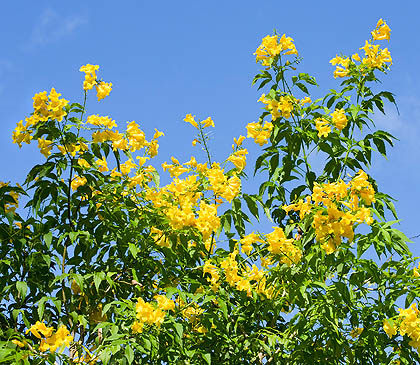Family : Bignoniaceae

Text © Pietro Puccio

English translation by Mario Beltramini

Sun-loving plant, very common in the Tropics © Giuseppe Mazza
The name of the genus is the abbreviation of the Mexican name in Nahuatl (Aztecan) “tecomaxochitl”, which can be translated with “cup-shaped flower”; the name of the species is the present participle of the Latin verb “stare” = to stand up, to stay upright, with reference to its erect posture.
Common names: “tecoma gialla” (Italian); “trumpet-bush”, “trumpet-flower”, “yellow trumpet-bush”, “yellow-bells”, “yellow-elder”, “ginger thomas” (English); “trompette d’or”, “bois pissenlit” (French); “esperanza”, “guarán amarillo”, “roble amarillo”, “bignonia amarilla”, “lapachillo”, “guaranguay”, “garrocha”, “marangaya”, “vainillo” (Spanish); “bignonia-amarela”, “guara-guara”, “ipê-amarelo-de-jardim”, “ipezinho-de-jardim”, “sinos-amarelos” (Portuguese); “Gelber Trompeten- strauch” (German).
Shrub or small semi-deciduous tree, much ramified, which can reach a height of 7-8 metres, with greyish wrinkled bark and imparipinnate leaves composed of 3-9 lanceolate small leaves with jagged margins and sharp apex, long up to about 10 cm, of a pale green colour. The inflorescences are terminal or sub-terminal, carrying several bright yellow tubular-campanulate flowers, with slight striae on the throat, 4-5 cm wide and gently perfumed. The fruits are linear capsules, long up to 20 cm, brown when ripe, containing several oblong, papery, flat and winged, seeds, of about 4×8 mm. It easily reproduces by seed or by semi-woody cutting in summer.
Plant very spread, besides its origin areas, in all tropical and subtropical countries, in some of which it has naturalized, thanks to its showy and long-lasting blooming; it is the national flower of Bahamas and of the U.S. Virgin Islands. It can be cultivated also in warm-temperate climates, where, however, it loses the foliage in winter and can get the aerial part damaged already with temperatures close to -3°C, particularly in the case of young plants; adult ones can stand lower temperatures, even if losing the aerial part which will grow up again from the foot of the plant upon the following spring. It is cultivated preferably in full sun and is not much particular in the soil, when adult is also drought-tolerant. It is to be kept under control with regular pruning, as it tends to ramify a lot starting from the base, in order to avoid a disorderly look. Extracts of leaves, flowers and bark, are utilized in the traditional medicine, researches have pointed out the presence of monoterpenoids which might have a future application in the treatment of diabetes.
Synonyms: Bignonia stans L. (1763); Gelseminum stans (L.) Kuntze (1891); Stenolobium stans (L.) Seem. (1863); Bignonia frutescens Mill. ex A. DC. (1845); Bignonia incisa hort. ex A. DC. (1845); Gelseminum mollis (Kunth) Kunth (1898); Stenolobium incisum Rose & Standl. (1913); Stenolobium quinquejugum Loes. (1919); Stenolobium stans var. apiifolium (hort. ex A. DC.) Seem. (1863); Stenolobium stans var. multijugum R.E. Fr. (1903); Stenolobium stans var. pinnatum Seem. (1863); Stenolobium tronadora Loes. (1919); Tecoma incisa Sweet (1827); Tecoma molle Kunth (1819); Tecoma stans var. angustatum Rehder (1915); Tecoma stans var. apiifolia hort. ex A. DC (1845).
